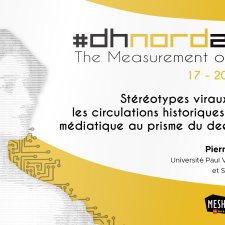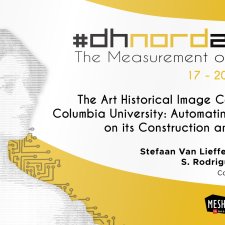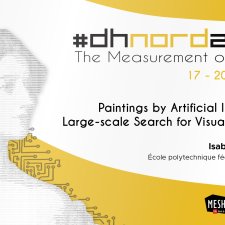Notice
Angelic Movement. Exploring and Understanding Art, Iconography and Composition with Machine Learning
- document 1 document 2 document 3
- niveau 1 niveau 2 niveau 3
Descriptif
The progress of computer vision and deep learning could not be adapted on artworks directly. Even if art represents reality, the perception is different in comparison to photos. Additionally, particular scenes, such as the Annunciation can be given in various settings, compositions, styles and techniques. Thus for art history and other fields analyzing cultural heritage, specific, applied approaches must be developed. We analyze the similarity of whole images across iconographies and we explore the variety inside an iconography. One key in the manifold of representations is the pose. The pose can help to compare compositions and to analyze the narration. Another approach towards image understanding is detecting the objects which form the scene. Convolutional Neural Networks need big data to be trained. This was one reason to focus on christian art and very prominent iconographies like the Annunciation or the Adoration of the Magi and Shepherds. Only with these canonical, ubiquitous scenes could we reach more than 20 000 pictures per iconography. This number not only enables the use of CNNs, it also allows us to see the diversity of motives through the centuries in distant viewing. I want to show how we explore and analyze this data being inspired by art historians like Michael Baxandall, Max Imdahl and obviously Aby Warburg.
Peter Bell (University of Erlangen-Nürnberg)
Thème
Dans la même collection
-
Tracking the Circulation of Images Digitally: From Artistic Cartography to the Study of Visual Cont…
JOYEUX-PRUNEL Béatrice
1ère intervention de la 1ère session du colloque DHNord 2020
-
Transfer Learning and Visualization of Neural Networks for Artistic Images
1ère intervention de la 2e session du colloque DHNord 2020
-
Stéréotypes viraux : analyser les circulations historiques de l'image médiatique au prisme du deep …
LANGLAIS Pierre-Carl
3e intervention de la 1ère session du colloque DHNord 2020
-
From One Image to Another: Circulations, Transmissions, and Intervals
Table ronde de la 1ère journée du colloque DHNord 2020
-
Understanding Images Through Machine Learning and Deep Learning
Table ronde de la 2e journée du colloque DHNord 2020
-
The Art Historical Image Collection at Columbia University: Automating Research on Its Construction…
2e intervention de la 1ère session du colloque DHNord 2020
-
Paintings by Artificial Intelligence. Large-scale search for visual similarities
4e intervention de la 1ère session du colloque DHNord 2020








